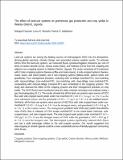| dc.description.abstract | Land-use systems are among the leading sources of anthropogenic GHG into the atmosphere; driving global warming, climate change, and associated extreme weather events. To estimate GHGs from the land-use systems, we measured fluxes (positive/negative emissions per unit of time) of carbon dioxide (CO2), nitrous oxide (N2O), and methane (CH4) from the cropping and adjacent non-cropping systems in Wakiso District, Uganda. The study comprised of 9 treatments with 2 inter-cropping systems (banana-coffee and maize-beans), 4 sole-cropped systems (banana, maize, beans, and sweet potato), and 3 non-cropping systems (fallow lands, pasture lands, and grasslands). Four management practices: mulching with no-tillage (mulched-NT); non-mulching with reduced-tillage (non-mulched-RT); non-mulching with deep-tillage (non-mulched-DT); compositing with reduced-tillage (compost-RT) were embedded in the cropping systems. The study also assessed the effect of the cropping systems and their management practices on crop yields. The GHG fluxes were monitored using the static chamber technique and analysed using a gas chromatography (G.C.). The results showed that all the land-use systems were sources of CO2 flux with sole-cropped sweet potato under non-mulched-DT (148.12 ± 3.4 μg C m−2 h−1) as the most substantial source, and the grasslands (33.03 ± 1.7 μg C m−2 h−1) as the weakest source. Similarly, all the land-use systems were sources of N2O flux with sole-cropped beans under non-mulched-RT (14.21 ± 0.4 μg N m−2 h−1) as the strongest source, and grasslands (3.43 ± 0.4 μg N m−2 h−1) as the weakest source. The management practices were sinks (any system that absorbs more GHGs than it releases) of CH4 except mulched-NT in the maize-beans intercrop, sole-cropped beans, and sole-cropped maize. The sole-cropped sweet potato under mulched-RT (0.3 ± 0.01 μg C m−2 h−1) was the strongest source of CH4, while the grasslands (−0.67 ± 0.01 μg C m−2 h−1) were the strongest sink. The intercropped systems significantly reduced GHG fluxes and had a yield advantage relative to the sole-cropped systems. Our results suggested that intercropping in central Uganda could be a more sustainable and eco-friendly approach concerning GHG fluxes. | en_US |

